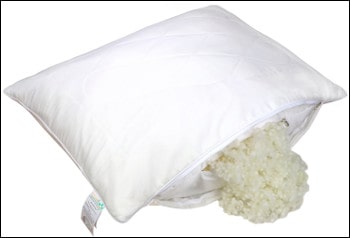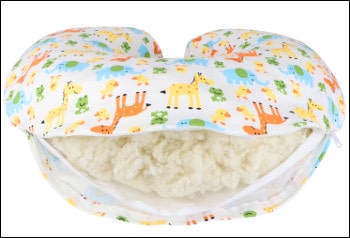How to Care for a Wool Pillow
Compression and Airing
Wool pillows, like any other pillows, can accumulate dirt, dust, dead skin cells, sweat, body oil and the cover tends to yellow over time. Many of us have invested quite a bit of money in a nice wool pillow and do not want to part with it. Some customers get emotionally attached to their pillows and have a hard time finding a replacement. The others have allergies and need to sleep on wool pillows. Wool filled pillows have many benefits that other pillows do not have. Wool pillows are anti-bacterial, naturally resists dust mites, mold and mildew, wick away moisture and are resist fire which means that they do not contain fire retardants. Luckily, with proper care wool pillows will serve you a long time even if they get dirty, sweaty or oily. We recommend purchasing an adjustable fill wool pillow that has a zipper on the side for removal of the wool filling. They are easier to maintain than the pillows without zippered covers.

Adjustable fill wool pillow
Keep in mind that wool filled pillows will naturally compress 30-40% within the first few months of use. Thus, if you ordered the pillow that is too high for you, you can unzip the case, remove the extra filling and add it later when your pillow gets compacted from the weight of your head and body moisture. To refluff the pillow place it in a dryer with two tennis or dryer balls, set the the dryer on “air only” or “low heat” setting and let it spin for about 10 minutes.
Always use your pillow with a pillowcase that will partially protect your pillow from the above effects. Envelope closure pillowcase does a better job at protecting a pillow because it does not expose one end of the pillow like a conventional pillowcase does. Use multiple pillowcases if you expect a lot of soiling. Wash your pillowcases at least twice a month.

Adjustable fill wool nursing pillow
Remove the pillowcase and air your pillow in the sunlight on a dry day from time to time. Wool is an active fiber that absorbs moisture from your body. Sunning your pillow outside will release the moisture and restore the loft of your pillow. If you have an adjustable wool nursing pillow you can remove the slipcover and air the pillow.
Washing Cover vs. Whole Pillow
The wool filling used for pillows can be either big sheets of wool batting or tiny wool puffs also known as wool bits, pearls or bolas. Our wool pillows are filled with wool puffs. Before washing make sure that the zipper is fully closed so that the wool filling does not leak during washing. Wash your wool pillow with a mild detergent or a wash specially formulated for wool such as Kookaburra, Woolite or Eucalan. Technically pillows filled with wool puffs are washable but do so only if that is absolutely necessary because washing makes the wool puffs clump a little bit which results in a less springy filling. You can tear the wool clumps but the filling may not regain the original loft. After the pillow is completely dry, you can use a dryer to fluff it up. Instead of washing the entire pillow we recommend unzipping the pillow, removing the wool puffs and washing only the case. However, if you need to wash the entire pillow you can hand wash or machine wash following the instructions below.
Hand Washing
- Remove the pillowcase or the slipcover. Check to make sure the zipper of the case is fully closed.
- Partially fill bath tub or a big sink with cold or lukewarm water. Add a small amount of detergent or wool wash.
- You can also add a table spoon of baking soda to eliminate any odors.
- Submerge the pillow in water. It will tend to bob to the surface while it is absorbing water. Keep pushing it down until it sinks.
- Gently swirl and squeeze pillow. Do not rub or agitate. Let it soak for about 15 minutes.
- Drain soapy water and refill the tub or sink with clean water. Swish the pillow around, squeezing out soap. Repeat the rinses until the water is reasonably clean.
- Squeeze out as much water from pillow as you can. Wrap it in a dry towel and squeeze out any excess water.
Machine Washing
- Fill the machine with cold or lukewarm water and turn it off. Add a small amount of detergent. Can add a table spoon of baking soda to eliminate the odors.
- Submerge pillow in water and keep pushing it down until it sinks.
- Add a bath towel. This will help balance the load and spin evenly.
- Gently swirl and squeeze pillow. Do not rub or agitate. Let it soak for 15 minutes.
- Turn machine to rinse skipping the agitating wash cycle. Let machine fill with water and turn it off. Swish pillow around in the rinse water.
- Turn machine to spin. When the cycle is over wrap the wet pillow in a dry towel and squeeze out any excess water.
Steaming the Wool Filling
The wool filling can be sanitized and re-fluffed by steaming.
- Find a big pot, fill it with about an inch of water and boil it.
- Set a colander or steamer basket above the water.
- Steam big handful of wool for up to 2 minutes.
- Empty the colander, add more wool and repeat until the entire pillow content has been steamed.
- Dry the wool and re-stuff the pillow.
Drying
You can line dry the whole pillow but your pillow will dry faster if you remove the wool filing.
- Unzip the case and remove the wet fiber. Spread it out flat in a thin layer on a towel to air dry.
- Machine dry only the case.
- Pull apart any clumps. Sort through the wool and break apart any larger clumps. If you work diligently you will find that this is a pretty time consuming process. You can work on it while the wool is drying. On average the wool filling takes about 24 hours to dry.
- You can dry the wool puffs in a well ventilated place indoors. Alternatively, you can dry the fiber outside in the sun in your balcony, deck or back yard. However, if you feel a breeze put a cheesecloth over so that the wool fiber does not get blown away.
- Once the wool puffs are completely dry, take handfuls of puffs and put them back into the zippered case. Put your hands inside the case and distribute the wool filling as evenly as you can. Zip up the case. If you see that the surface of the pillow has some humps or wells, unzip the case and try to level out the wool. Put on the pillowcase or the slipcover.
Dry Cleaning
Wool pillows are also dry cleanable but dry cleaning may leave toxic chemicals in your natural pillows. If you want to dry clean consider going to a certified “green” dry cleaner.


 Pay in 4 lets you split your purchase into 4 interest-free payments. The first payment will be due at the time of purchase and 3 subsequent payments will be taken every 2 weeks thereafter. PayPal account that can be set up at the time you choose to pay with PayPal. Your item ships after you put down 25%.
Pay in 4 lets you split your purchase into 4 interest-free payments. The first payment will be due at the time of purchase and 3 subsequent payments will be taken every 2 weeks thereafter. PayPal account that can be set up at the time you choose to pay with PayPal. Your item ships after you put down 25%.